To better understand India’s Covid outbreak and the ruling BJP Party’s role in this crisis, I spoke to New Frame journalist Haris Zargar. Haris, whose work I’ve long admired, discusses the situation on the ground, how the pandemic is trending, and what implications the crisis has for India’s present and future.
Asia Art Tours: We often mistake wealth for competence. In countries like Vietnam, Bhutan or Rwanda, we’ve seen competent handling of the Covid-19 pandemic in countries with far fewer resources than India. What specific mistakes or deliberate policy choices did the BJP make which has allowed the Covid pandemic to become so severe within the country?
Haris Zargar: The mistakes arguably are multi-fold; certainly made at the top political echelon. Despite India’s remarkable economic progress in the recent decades, a significant percentage of Indians live in extreme poverty and largely operate in the informal sector, as social inequality - linked to caste, class, religion, gender, etc – keeps them disempowered and marginalised perpetually. The expansion of neoliberal policies under Modi’s administration has worsened these economic disparities and social exclusion. The situation is further exacerbated by the pandemic that has reportedly pushed an estimated 230 million Indians into poverty during the past year. About 90% of workers in India engage in the informal economy, with few safeguards for job security, access to medical care, and other state-sponsored social welfare programmes such as direct cash transfers.
When the Modi government hurriedly declared a nationwide curfew in the aftermath of the first wave of the pandemic, millions of vulnerable urban migrants and their families began making frantic journeys on foot back to their rural homes in order to survive the devastating loss of income that had brought them to the verge of starvation. Despite acknowledging that the repatriation of workers may carry the virus into rural India, the government did not create guidelines for such migration, or made transportation available for travel; nor did it reassure or provide workers with food, shelter, and medical care. Coordination between states was likewise non-existent. The economic impact of the lockdown was severe, and the poor were brutalised.
As the second wave of coronavirus outbreaks raged across the country, Modi’s BJP administration allowed the Kumbh Mela, a religious gathering in which millions of Hindus gather to take a sacred bath in the river Ganges. Leaders from the Prime Minister’s own party attended the event despite all COVID-related fears, claiming that the virus would not hurt Hindu worshippers. This event drew an estimated 9.1 million people, and as the devotees went home on crowded buses and trains, they spread the virus in the villages and towns.
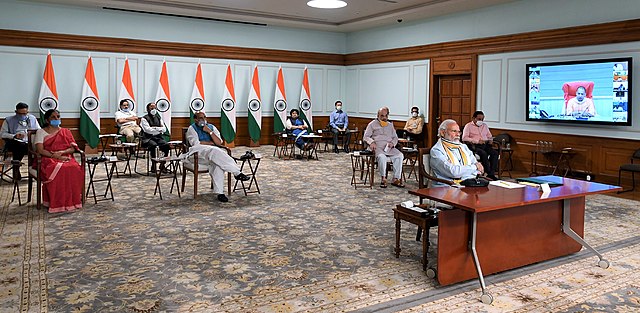 Prime Minister, Narendra Modi meeting with State Chief Ministers via video conferencing . Photo Credit: WIKIPEDIA
Prime Minister, Narendra Modi meeting with State Chief Ministers via video conferencing . Photo Credit: WIKIPEDIA
Likewise, when the citizens were struggling to find basic healthcare assistance and making frantic social media appeals for drugs and oxygen, Modi and his party leaders mounted a huge political campaign in West Bengal, Tamil Nadu and Kerala state elections. Modi personally attended a number of gatherings where people defied social distancing rules with Modi, who addressed crowd without a mask, expressed being “elated” to see such a large gathering. Despite an increase in infection and mounting criticism for prioritizing politics above the pandemic, the BJP defended their election campaigns, claiming there is no relationship to the surge in infections.
When the Modi administration came under fire from the foreign media, the BJP government chose to concentrate its efforts on controlling media narratives and managing public opinion rather than stepping up measures to combat the pandemic. The mismanagement of vaccine production and distribution, and lack of coordination with state government only compounded the problem. Despite warning from health experts that a second wave was imminent, the Modi government chose to provide vaccines to other nations as part of its vaccine diplomacy and image management. When the second wave hit the country, it found itself short of vaccines, and forcing the owner of the company that produces covid vaccine to flee the country.
 A passenger being tested for Covid-19 before being allowed to board a train. Photo Credit: WIKIPEDIA
A passenger being tested for Covid-19 before being allowed to board a train. Photo Credit: WIKIPEDIA
Asia Art Tours: I’ve been thinking about biopolitics as it relates to the BJP and Hindutva. Broadly speaking, the BJP uses dehumanizing language designed to separate Indians into the worthy (those who are Hindu or support the BJP) and unworthy (those who are Muslim, or oppose the BJP).
For those in power within BJP and the RSS, how have they reacted psychologically to a disease that does not care if one is Hindu, Sikhi or Muslim? That does not care if one is Brahmin or Dalit? How have they reacted to having overseen one of the largest mass deaths of Indians in modern history?
Haris Zargar: The pandemic sparked a new surge of Islamophobia and hatred toward Muslims, whom the pro-statist media and politicians affiliated with the BJP claimed were deliberately spreading the virus. The community was accused of engaging in coronavirus jihad fanned by Hindu nationalist media and amplified by pro-BJP and pro-Modi social media accounts. The accusations were weaponised to further stigmatise, target and marginalise Muslims. The covid testing was also exploited by law enforcement to identify Rohingya refugees and place them in jail centres for allegedly residing illegally in the country.
While the Hindu religious gathering were allowed by the BJP administration, which further spiked covid infection, these events were used to reinforce the ideological commitment of the state towards Hindu majority. With media largely beaming mild critical voices that largely centred on deflecting the blame either on previous Congress government or local administration, pro-Modi sentiment still remain intact. The media also tried to target anti-farm law protestors, who are stationed just outside the capital Delhi, as potential ‘super spreaders,’ to force the farmer unions to call off the protests.
Though the virus has effected every section of the Indian society, the negative fallout of the pandemic on political fate of Modi is still too early to be predict. There is no doubt his positioning as an effective leader has taken a toss, but at the fact that Modi has become a messiah like figure in the imagination of Hindutva supporters and in my view of many observers now bigger than the BJP and it parent organisation, the RSS, of which Modi has been a life long devotee. Modi’s BJP may likely suffer electoral defeat in the key upcoming state elections in the Uttar Pradesh and Gujarat, but with national polls set for 2024, there is still be time for Modi and BJP to reconsolidate their position, especially given that there is still no major political opposition that can challenge them.
 A police officer wearing a ‘Covid-19 Mask’ to inform citizens on the need to wear masks. Photo Credit: WIKIPEDIA
A police officer wearing a ‘Covid-19 Mask’ to inform citizens on the need to wear masks. Photo Credit: WIKIPEDIA
Asia Art Tours: Even before holding mass election rallies during a global Pandemic, the BJP has always been explicit in their strategy of victory at any cost. Those who do not contribute to or those who oppose their political or neoliberal dreams, (Sikhi farmers, Muslims, Kashmiris, Migrant laborers, or academics), have been abandoned, targeted or sacrificed.
In this current crisis, what groups & demographics has the BJP decided to abandon to fend for themselves to the pandemic?
Haris Zargar: Despite being aware of a potential vaccine scarcity, the Modi regime initially also refused to provide clearance for new vaccines, such as the Sputnik V, to be used in India. It placed a disproportionate amount of reliance on the ability of two private enterprises to expand their vaccine manufacturing capacity. The administration also deregulated vaccine prices and liberalized vaccine sales – a measure that would make vaccinations costly, denying millions of poor and marginalised Indians, especially Dalits, Adivasis, destitute, other backward classes etc., access to immunizations. The BJP government even cancelled the existing insurance scheme for those healthcare workers who die in the line of COVID-19 duty.
At least two key misconceptions about PM Modi and his government have been busted by the COVID crisis: his effective leadership abilities and his commitment to the welfare of the country’s Hindu majority. The staggering scale of despair and death across the country has only revealed the bogus nature of such claims often made by the Hindu right. The Modi government not only abdicated its covid management obligations and passed the responsibility to the states, his government has showed little concern or urgency about combating the virus even in the state ruled by the BJP or constituency represented by Modi himself.
In summation, citizens of the country – regardless of ethnicity, religion, caste, or geography, and even those who have been BJP’s ardent supporters, have been abandoned by the Modi government. Instead of investing in healthcare infrastructure, vaccine manufacturing, and vital drug procurement, the BJP government continue to spend millions on non-essential projects like the Central Vista revamp, which includes enormous official mansions for the vice president and prime minister, and a new parliament house.
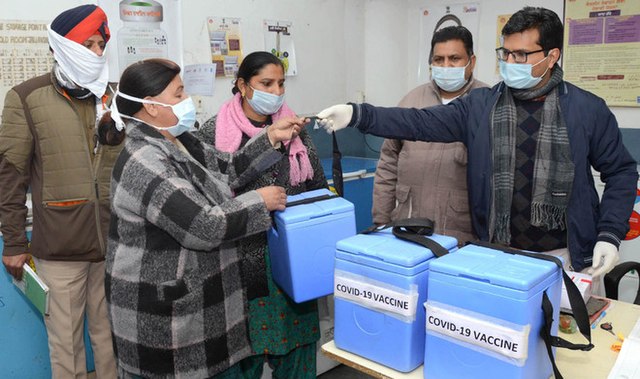 Covid Vaccines being delivered to the public. The controversial application used to register to receive the shots (CoWIN) is another point of controversy over the BJP’s handling of the crisis. Photo Credit: WIKIPEDIA
Covid Vaccines being delivered to the public. The controversial application used to register to receive the shots (CoWIN) is another point of controversy over the BJP’s handling of the crisis. Photo Credit: WIKIPEDIA
Asia Art Tours: And how has the BJP, following the neoliberal maxim of ‘never letting a serious crisis go to waste’, used Covid to punish those who oppose it? Or to push through policies that it sees as essential to its political and economic vision?
Haris Zargar: Amidst the raging pandemic, Modi government continue to target NGOs, civil rights groups, dissenting media outlets, rights activists and students. When Indians resorted to social media to seek support for their family and friends, the Modi government retaliated by cracking down on platforms like Twitter in an attempt to quell criticism. At the behest of the Indian government, Twitter was forced to suppress messages concerning Covid-19, particularly those critical of Prime Minister Modi’s handling of the pandemic.
I argue the platform was compelled because, in the midst of the outbreak, the Modi administration enacted new laws that may hold them accountable for failing to remove contentious messages. Using the covid emergency to force laws through the ordinance route, the Modi government implemented unpopular legislation like as new agriculture bills and labour law amendments without engaging Parliament or key stakeholders. These rules essentially disempowered millions of small and impoverished farmers and informal labourers, prompting hundreds of thousands to march in the middle of the coronavirus outbreak. These neoliberal laws are designed to suit big corporates some of whom have deep links with PM Modi.
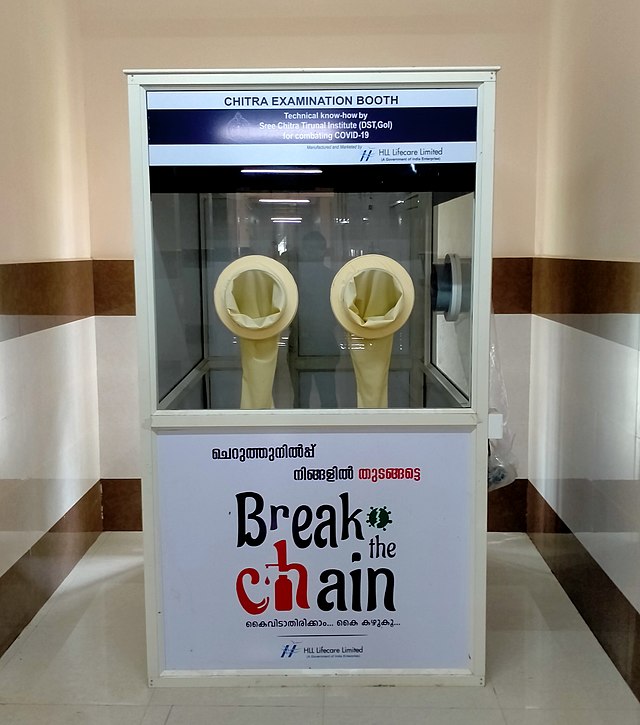 A Covid rapid-Testing Booth in the state of Kerala. Kerala’s public response to Covid has been perhaps the best in all of India, and stands in sharp contrast to how the pandemic has been handled by States controlled by the BJP Party. Photo Credit: WIKIPEDIA
A Covid rapid-Testing Booth in the state of Kerala. Kerala’s public response to Covid has been perhaps the best in all of India, and stands in sharp contrast to how the pandemic has been handled by States controlled by the BJP Party. Photo Credit: WIKIPEDIA
Asia Art Tours: In recent elections, the BJP has been dealt setbacks in States where it had expected to make gains. Could you discuss if you see these results as an outlier, simply related to the current Covid crisis in India? Or do you see these results pointing to the beginning of an ideological framework that stands in opposition to the BJP, Neoliberalism or Hindutva?
Haris Zargar: The recent electoral losses for Modi’s ruling party in Kerala, West Bengal, and Tamil Nadu certainly signal to a regional opposition to the BJP. However, the BJP losing state legislature and local body elections is not a new occurrence, and the right-wing party have been regularly faced defeat in various states, including in Rajasthan, Chhattisgarh, Jharkhand, and even in Maharashtra by its former key ally. In these elections people often vote for local legislators and candidates on the issues concerning economic development, job opportunities, corruption, and other social welfare programmes. The BJP routinely fails to deliver on such matters.
At the national level, however, Modi and his ruling party continue to hold sway over a much diminished, or effectively non-existent, political opposition. National security, Hindutva nationalism, regional hegemonic aspirations, anti-Pakistan discourse, Kashmir, and identity politics remain central to the BJP’s national rhetoric. The Modi government effectively continues to retain a popular imagination of the majority Hindus, especially given the fact that much of India’s enormous media industry broadcasts overwhelming statist propaganda on a daily basis, which harbours prejudicial attitudes towards Muslims, other minorities and marginalised communities including Sikhs, Dalits, Adivasis etc, left-leaning groups, civil rights bodies, journalists and activists.
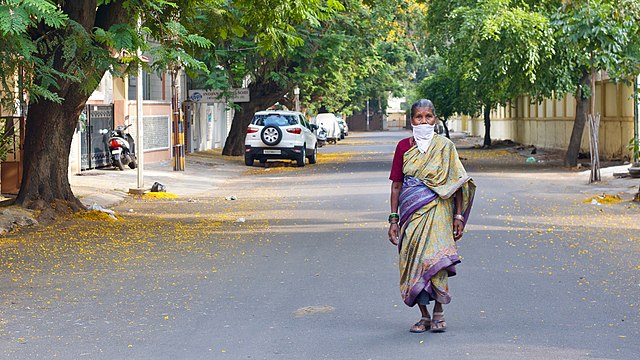 A lone woman, walking down a lock-downed city. Photo Credit: WIKIPEDIA
A lone woman, walking down a lock-downed city. Photo Credit: WIKIPEDIA
Covid-19 crisis has no doubt made a dent on Modi’s public image and it remains the single biggest challenge his administration has faced since coming to power in 2014. If the BJP-led government fails to bring some relief to people and to control further spread of virus, its will be difficult for Modi to retain power in the next elections. But at the same time, although there has been criticism of PM Modi recently, much of the anger has been directed at erring BJP Lawmakers, bureaucracy, local administration, and other entities rather than against Modi directly. At an ideological level, Modi and the RSS has been able to reengineer the India’s society, institutions such as the judiciary etc, and military and law enforcement agencies. The appropriation of Hindu politics by BJP has also forced Modi’s political opponents, which previously spoke of upholding secular and liberal values, have been adopting communally polarising Hindutva politics. This effectively has reshaped how politics in the country will be dictated in the years to come that arguably may be unleash more communal violence, further ‘othering’ of the religious and ethnic minorities and stifling of any form of dissent.
Moreover, Modi regime has consistent with its neoliberal pro-business stance. Using the pandemic emergency as a cover, his government removed environmental safeguards to push faster clearance of projects in ecologically fragile areas, rushed to approve hydropower projects, allowed extractive mineral industry to operate without environmental clearances, deregulated agriculture through farm laws, removed key labour laws that provided some safeguards to labourers and workers etc. This violent mix of neoliberal Hindutva has left million disempowered, displaced and dispossessed. Big corporates have a greater say in policy making that is inherently skewed in favour of businesses at the cost of poor. With the judiciary abdicating its role to check the ruling political classes, and law enforcement agencies, the government is effectively having a free run.
 Sanitation workers spraying disinfectant. Photo Credit: WIKIPEDIA
Sanitation workers spraying disinfectant. Photo Credit: WIKIPEDIA
Asia Art Tours: To conclude, You’ve written eloquently about how Bollywood and Cricket have been used by the BJP to help spread its Hindutva ideology. Are there any individuals within these sites of cultural production who have stood up to the BJP and this most recent crisis?
Haris Zargar: India’s soft power image, which is frequently promoted through Bollywood, cricket, and Yoga, among other things, has proven to be a successful instrument for both domestic consumption and international diplomacy. Bollywood has long been a key transmitter of mainstream culture in India, producing films that conform to conservative Hindutva ideology. Mainstream Hindi cinema has especially been used to convey nationalistic messages that often promoted otherization of Muslims, Adivasis and Dalits. It used cinema to justify military actions in conflict zones such as Kashmir, or Naxal dominated areas of central India. Not just Bollywood actors, many public figures, especially cricketers, have been closely associated with the ruling political dispensation, either by amplifying the government’s propaganda or by joining the political bandwagon.
For a nation that have blindly follow Bollywood and cricket stars, any endorsement from their part become effective in mobilising the public sentiment in favour of the regime. Such close association has also allowed cinematic projects that aim to peddle the Hindutva version of India’s political and social history that often villainising minority communities such a Muslims or Dalits, or to retell historic events that show ideologues of Hindutva in good light. In that sense, the dominant political narratives in today India’s has been deeply influenced by the popular cultural transmitters such as the Bollywood.
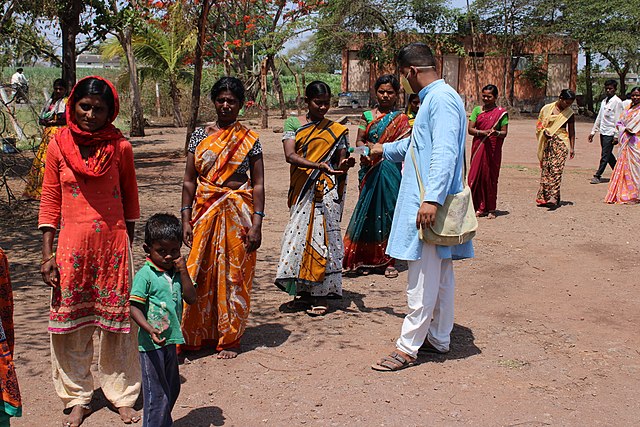 Private Aid being distributed to villagers. The BJP has been criticized by some for not providing aid to the poor, rural or migrant communities of India. Photo Credit: WIKIPEDIA
Private Aid being distributed to villagers. The BJP has been criticized by some for not providing aid to the poor, rural or migrant communities of India. Photo Credit: WIKIPEDIA
For more with Haris Zargar, please see his writing at New Frame.
You can also follow his Twitter account: @harriszargar
